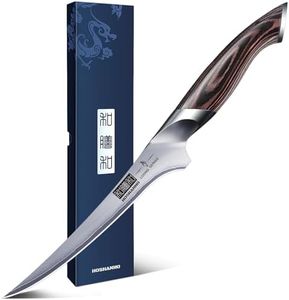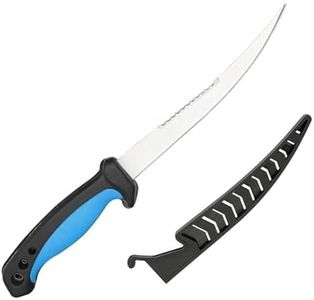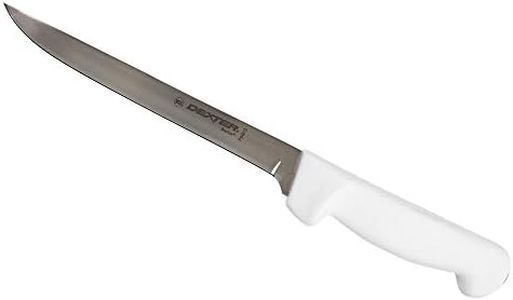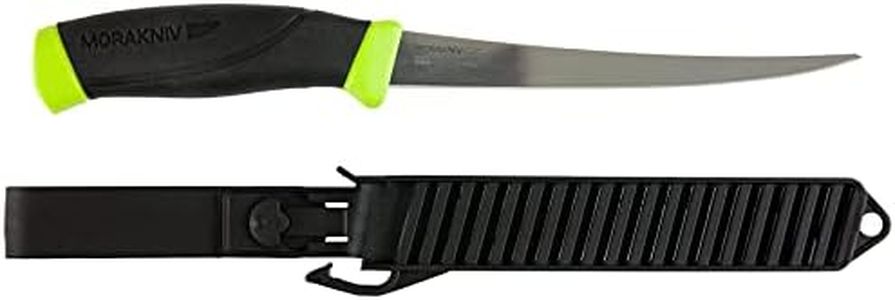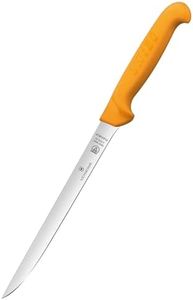We Use CookiesWe use cookies to enhance the security, performance,
functionality and for analytical and promotional activities. By continuing to browse this site you
are agreeing to our privacy policy
10 Best Saltwater Fillet Knife
From leading brands and best sellers available on the web.Buying Guide for the Best Saltwater Fillet Knife
Choosing the right saltwater fillet knife is about matching the tool to your fishing habits, the type and size of fish you typically catch, and the environment you'll be working in. A well-chosen fillet knife makes cleaning and preparing fish easier, safer, and yields better results. Saltwater environments can be particularly harsh on gear, so it's important to consider durability and corrosion resistance as well as the knife’s effectiveness in filleting different types of fish.Blade MaterialBlade material determines the knife's sharpness, durability, and especially its resistance to corrosion—which is crucial for saltwater use. Stainless steel is the most common choice, but not all stainless steels perform equally in a marine environment. Some alloys are specially coated or blended to resist rust from saltwater exposure. If you frequently clean your knife and store it dry, even standard stainless steel can last, but for heavy saltwater use, look for knives specifically labeled as highly corrosion-resistant or marine-grade. Choose a material that balances edge retention and ease of sharpening based on your maintenance habits.
Blade LengthBlade length impacts how comfortably and efficiently you can fillet different sizes of fish. Shorter blades (around 6 inches) are easier to control and work well for small fish, while medium blades (7-9 inches) are the most versatile for a mix of small to large fish. Long blades (over 9 inches) are best for large fillets or big fish commonly found in saltwater environments. Consider the average size of fish you’ll handle; if you often fish for larger species, aim for a longer blade to make the process smoother.
Blade FlexibilityBlade flexibility describes how much the blade can bend during filleting. More flexible blades allow for precise, delicate cuts along bones and are perfect for smaller or softer fish, while stiffer blades are sturdier and better for tougher, larger species. Decide based on your target catch: if you prioritize detailed work with small fish, a flexible blade is ideal; but for thick, meaty fillets or larger saltwater fish, a stiffer blade gives you more strength and control.
Handle Material and GripThe handle’s material and design impact comfort, safety, and grip—especially when things get slippery. Handles made from rubber or textured polymers offer a solid, non-slip grip even when wet, which is very important for safety in saltwater settings. Wood handles can be comfortable but may not hold up well to constant salty moisture. If you plan to be out on the water or cleaning fish immediately after catching, prioritize a handle that feels secure and ergonomic in wet conditions.
Ease of Cleaning and MaintenanceEase of cleaning is crucial since saltwater can quickly corrode both the blade and handle if not well-maintained. Knives with simple designs without deep crevices or unnecessary screws are easier to rinse and dry completely. Some knives disassemble for thorough cleaning but still should be easy to put back together. If you fish often or don’t want to spend a lot of time on cleaning, choose knives designed to be low-maintenance with smooth, non-porous surfaces.
Sheath or StorageA good sheath protects the blade during transport and storage—both for safety and to prevent unnecessary exposure to saltwater or humidity. Plastic or synthetic sheaths allow for easy rinsing, and some include drainage holes, which are useful for saltwater use. If you’re carrying the knife on a boat or to the shoreline, ensure the sheath secures the knife firmly and is easy to attach to your gear or belt. Consider your storage situation to pick the sheath type that keeps your knife protected and ready for use.

